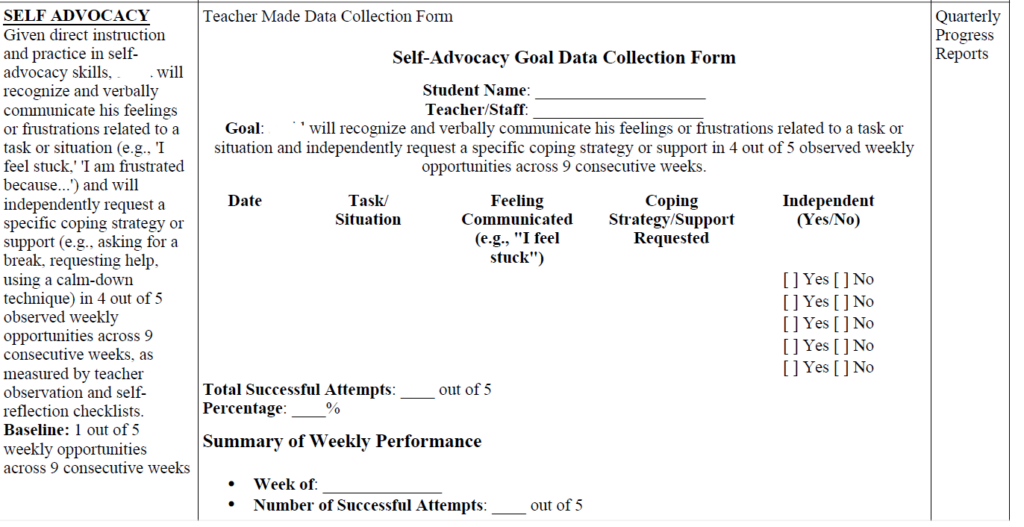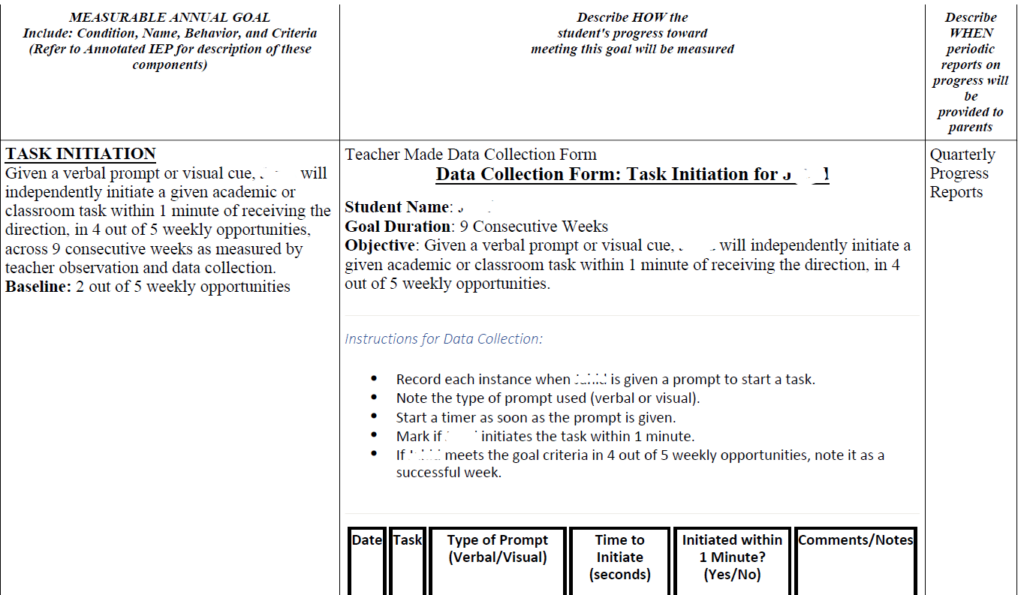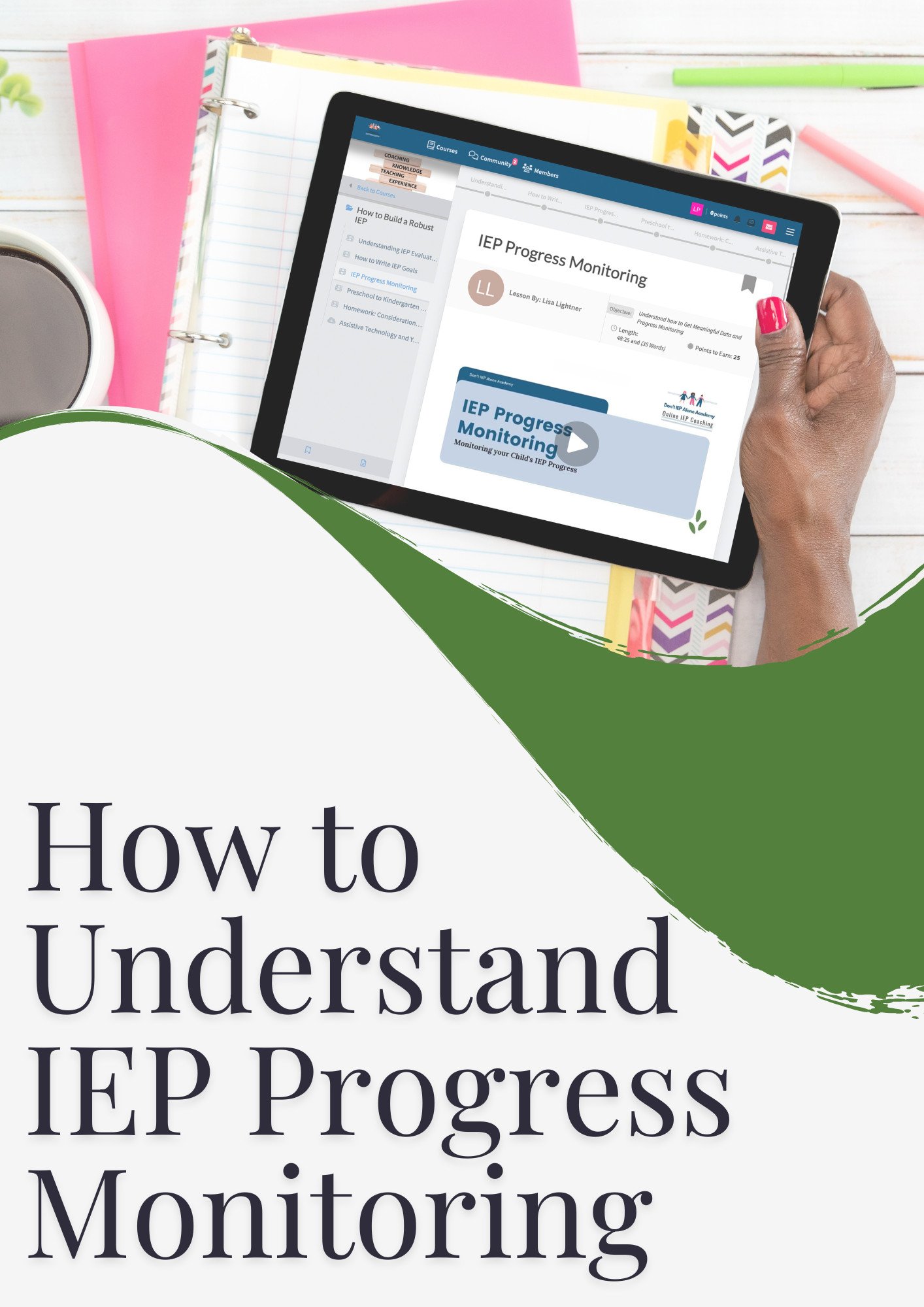IEP Progress Monitoring: A Parent’s Guide to Tracking Your Child’s Growth (With Examples!)
IEP Progress Monitoring and IEP Data Collection are among the most important things about an IEP. And yet tracking IEP goals is one area that I find parents cannot wrap their heads around it, so it gets neglected.
I am eternally grateful for Michelle and what she has contributed to this blog, including this post about IEP Progress Monitoring. The official term, or how IDEA references it, is Progress Monitoring. However, many parents (and school staff) may refer to it as IEP goal tracking.
She has included how to track IEP progress and what IDEA says about IEP Progress Monitoring, and then at the bottom, I have an IEP goal tracking sheet that is free for you to use.
Progress Monitoring IEP Goals
Definition of individualized education program (IEP)… an IEP will include…
(3) A description of—
https://sites.ed.gov/idea/regs/b/d/300.320
(i) How the child’s progress toward meeting the annual goals described in paragraph (2) of this section will be measured; and
(ii) When periodic reports on the progress the child is making toward meeting the annual goals (such as through the use of quarterly or other periodic reports, concurrent with the issuance of report cards) will be provided;
Parents spend a lot of time advocating for appropriate IEP goals for their kids to meet their individual needs. But one area of the IEP process that often gets lost in the shuffle is IEP Progress Monitoring.
What is IEP progress monitoring? Why is progress monitoring toward IEP goals needed? Who is responsible for each IEP goal? How do you progress monitor IEP goals? Are there any IEP progress monitoring tools? Most parents look at the goals and know in their gut that their child isn’t making progress. But they are not sure of what to do about IEP progress monitoring. This article is going to dig into the IEP progress monitoring pieces.
IDEA states that each child’s IEP must contain the following:
(3) A description of—
(i) How the child’s progress toward meeting the annual goals described in paragraph (2) of this section will be measured; and
(ii) When periodic reports on the progress the child is making toward meeting the annual goals (such as through the use of quarterly or other periodic reports, concurrent with the issuance of report cards) will be provided…[§300.320(a)(3)]
IDEA Requires Progress Monitoring for IEPs
IDEA requires every IEP to include a statement of measurable annual goals, including academic and functional goals. IEP goals should address the needs that result from the child’s disability and enable the child to be involved in and make progress in the general education curriculum. As well as meet the child’s other needs that result from the disability.
IDEA states that every IEP will contain the following:
- a description of how the child’s progress toward the annual goals will be measured.
- when periodic progress reports will be provided.
Where do IEP goals come from? Writing IEP goals starts with evaluating a child’s identified needs, but it doesn’t end there. An evaluation may identify a specific skill area of need, such as behavior, social skills, reading, math, etc.
IEP Present Levels are your Baseline for Progress Monitoring
IDEA also requires a statement of the child’s present academic achievement and functional performance levels. IEP Present Levels should show how the disability affects the child’s involvement and progress in the general education curriculum.
This focuses on the Present Levels of the IEP. Often called a PLAAFP, PLOP, PLEP, or just Present Levels, this is where the IEP begins. And it should be specific. The Present Levels is a summary describing the child’s current achievement and performance in the skill areas affected by the disability as determined by the comprehensive evaluation. The child’s strengths and weaknesses need to be pinpointed as to what the child can or is unable to perform in the general education curriculum.
IEP Progress Monitoring has to be more than just test scores. Copying a test core from an evaluation, such as a standard score of 76 on Written Expression, will not tell you about that child’s strengths and weaknesses. Nor will it tell you how the specific skill area impacts a child’s ability in the general education curriculum. Achievement evaluations will also not be able to be repeated at regular intervals for monitoring.
Present Levels are where goals come from and are the foundation for the IEP.
IEP Present Levels can include:
- skill based assessments
- benchmark tests
- classroom performance checklists
- work samples
- records review
- teacher reports
- Curriculum Based Measurements (CBMs)
- informal checklists
- rubrics
- parent input or parent concerns letter
- observations
Curriculum-Based Measurements CBM
CBMs are a scientifically validated form of student progress monitoring. CBMs are used throughout a period of time by probes at frequent intervals. Goals should be written from the baseline data from the Present Levels.
So as not to make this post longer than it should be, if you have more questions about either topic, please read the links below and then return to this post.
Why is IEP Progress Monitoring Important?
Ok, this is where many districts fail to see the big picture. From a parent’s perspective, it’s easy to determine why you would want to monitor your child’s progress toward their IEP goals.
But this is important for districts as well!
School districts can get important information to use, such as:
- assess student outcomes
- submit mandated state and federal reports
- in many states, claim Medicaid reimbursements
- help identify and support requests for additional staffing needs
- identify professional development gaps
- Guide the district’s specially designed instruction (SDI) strategies
- Make decisions about student growth
- Communicate progress on IEP goals, evaluations, placement
- Determine the effectiveness of providers, programs, curricula
Progress Monitoring IEP Goals
So what is IEP Progress Monitoring? IEP Progress Monitoring is frequently repeated measurement of performance in a specific area. Progress monitoring is provided to the parent to help them understand how the child is progressing.
But progress monitoring should also be used by the IEP team to make ongoing decisions about any changes or revisions necessary to the child’s IEP. Focusing on how that goal will be measured is critical in understanding, trusting, and seeing progress. The IEP decisions are based on data, so having objective data that tells the team how a child is progressing is a step that cannot be skipped.
Using IEP Writer (or another software program) is becoming increasingly common to provide IEP progress monitoring reports. These software programs easily allow IEP teams to reprint a goal, providing a space for the teacher or service provider to list the data and progress toward that goal.
If your school does not provide this information in a format that is easy for you to discern, you may want to consider the free printable IEP goal-tracking sheet I have provided below.
How do you Collect Data for IEP Progress Monitoring?
Decide where you want to start and where you want to end up — the baseline and the goal. For every goal, you want to ask the IEP team:
- How will progress be measured? Is this data objective?
- Who will measure the progress?
- What will be reported to parents?
- How often or when will progress be measured?
The same IEP progress monitoring process should be used for the length of the goal.
- Can this assessment or procedure be repeated at specific intervals?
- Was this data just from an observation?
- Was a checklist or rubric used to take the subjective nature out of the process?
An IEP should pass a stranger test, and that includes IEP goals. So if a child moves or a new teacher takes over a class, will that teacher be able to measure the progress in the same way? Is there a CBM that can measure this progress objectively? Will work samples, checklists, rubrics, and assessment data be shared with parents?
Gather Data, then Refer Back to the Baselines.
Looking back at the baseline data used to write the goal is also important in ensuring the goal is appropriate to target a specific need. I saw a goal the other day that targeted decoding by measuring comprehension. You cannot compare an apple to an orange. The specific need being targeted is the same need that should be measured.
IEP teams may find it easier to address this component of the IEP by framing the discussion around specific questions. For example, the IEP team might ask itself these three questions:
- How will the child’s progress be measured?
- When will the child’s progress be measured?
- How well will the child need to perform to achieve his or her stated IEP goals (or benchmarks or objectives)?
The information on how well a child must perform and how his or her progress will be measured is often called evaluation criteria. Well-written evaluation criteria are stated in an objective, measurable terms. It should be objective data. For example, reading X number of sight words on a cold read. And not, “his reading skills have improved.”
The data should reflect concrete numbers or scores rather than opinions. And, it should be apples-to-apples data for the entire IEP team to compare to the baselines in Present Levels.
How Often Should you Monitor IEP Progress?
Another progress monitoring piece to look at is the frequency of the progress reporting. Most schools use quarterly or report cards. The parent can advocate for more frequent progress monitoring, especially in critical areas. If the school has reported significant behavior or learning disability needs, it may not be appropriate to wait 9 weeks to know if the child is progressing.
If parents don’t address progress monitoring during the IEP meeting while the IEP is being developed, they likely will be very disappointed when progress reports are issued. Because the reports will lack the progress monitoring that includes actual data to know how the child is progressing, having a goal state observation, teacher-made tests, or a generic statement like “ data collection” is not specific.
I quoted IDEA above. It states “concurrent with….” grade reports. However, note that it does not say “only” with grade reports. And yes, as an advocate, I have seen IEPs that contain wording that only holds schools accountable for reporting progress (or lack thereof) to parents once a year.
This is another issue or detail that IDEA leaves up to the states, so double-check yours before approving a final IEP.
Red Flags in Monitoring IEP Goals and Progress
- Opinions and subjective data are often not accurate. Observations without checklists or rubrics are often not accurate.
- Grades are not objective assessments of progress since many factors can influence grades.
- IEP Goals are written to generalized grade-level standards. Of course, we want to close the gaps for our kids, so IEP goals should be written with grade standards in mind. However, be careful of non-specific goals such as “Johnny will write at 4th-grade level standards.” You want a goal to explain what the 4th-grade standard is, so the expected action is clear to everyone.
- Another red flag to look for is that goals aren’t measurable. Guessing a mood, feeling or attitude cannot be measurable.
- Vague goals are also not going to target specific needs and are often not measurable.
- Another red flag is when an IEP Goal does not have baseline data. You must know where the child currently is in their performance or achievement to be realistic about where you want them to end up.
- Also, be aware of skipping steps. While parents may want to advocate for specific services, special education services directly relate to the needs described in the Present Levels and goals.
So coming full circle, measuring a child’s progress toward goals begins at the present levels. If a child’s Present Levels are incomplete or inaccurate, the IEP cannot have meaningful, measurable goals. And without decent goals, you will not have appropriate support and services or decent IEP progress monitoring.
The above post on IEP Progress Monitoring is from one of my favorite advocates–Michelle Tilly. Thanks so much, Michelle!
Below I (Lisa) will add the spreadsheet we have to share.
Remember that IDEA says that schools must provide progress monitoring data to parents. It does not say how they must provide it, or how often. You may wish to use these IEP Goal Tracking Sheets to make monitoring progress easier.
It is a form of Progress Monitoring, but may not be as detailed as what some parents are looking for.
IEP Progress Monitoring Examples
I like what these teams have done.


Not crazy about this. I am aware that this is how this program works. But in this format, it does not allow for meaningful parent participation.



